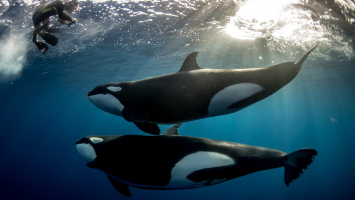Top 11 Interesting Facts about Beluga Whales
Belugas stand out among the more than 80 species of cetaceans that inhabit the waters. These sociable marine animals have easily recognized in their Arctic ... read more...habitat thanks to their unusual pale coloring and small height. Despite being well adored, belugas are more fascinating and remarkable than some casual admirers may believe. Here are interesting facts about Beluga Whales.
-
Belugas are toothed whales, a varied group of cetaceans that also includes some bigger species like orcas and sperm whales as well as dolphins and porpoises. However, belugas are a part of the minuscule family Monodontidae, which includes just two extant species: narwhals and belugas. Despite having a lot of the same habitat, interactions between belugas and narwhals are not frequent, but they do occur. In one unusual instance, a narwhal that appeared to have been adopted was seen swimming among a big pod of belugas. Given their natural curiosity and friendliness, it makes sense that belugas would welcome a relative into their family.
Along with several neighboring seas, bays, fjords, and estuaries, the Arctic Ocean is home to both belugas and narwhals. While belugas are dispersed in various regions of the Arctic, North Atlantic, and North Pacific, narwhals mostly travel the Arctic and North Atlantic. Belugas can go inland through rivers, sometimes quite a distance, since they have adapted to both fresh and saltwater. The two species do cohabit in some regions, and at least one beluga-narwhal hybrid has been spotted in the wild.

en.wikipedia.org 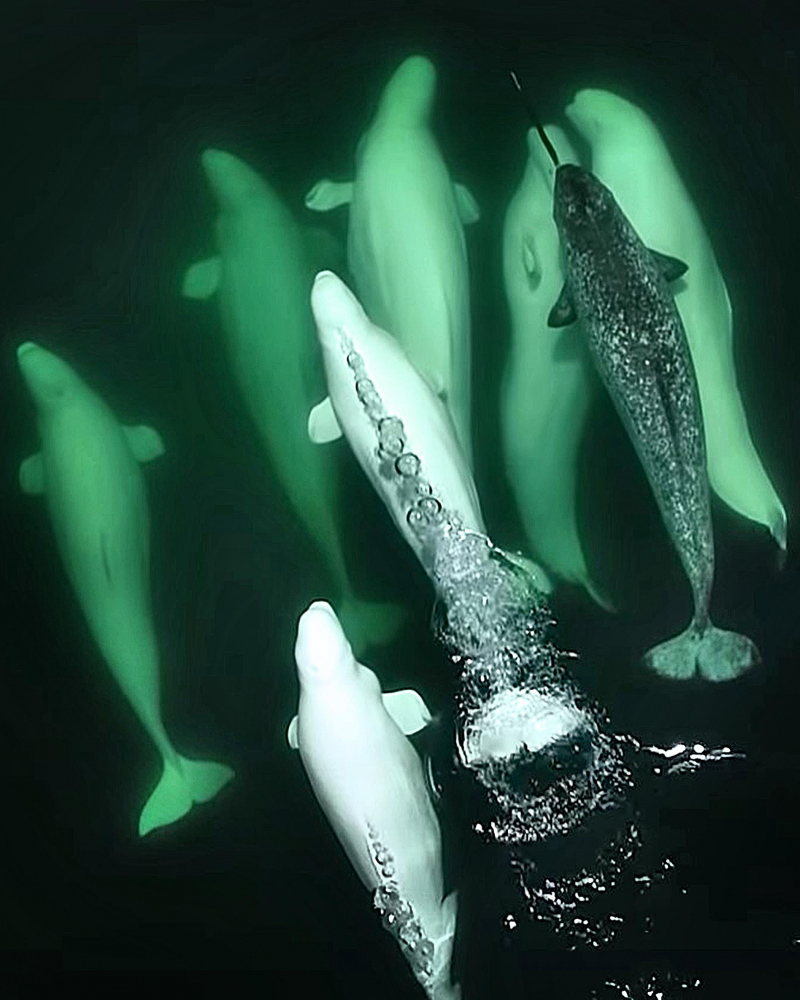
en.wikipedia.org -
Since many species of whales and dolphins make a wide range of sounds for social communication as well as echolocation, they are renowned for their intellect and loquacity. Belugas are thought to possess very advanced echolocation and hearing abilities, and the vocal range of these animals has led to parallels to songbirds. The term "sea canary" is another, much nicer-sounding moniker belugas have acquired for themselves, and it originates from the animal's rich and diverse vocalizations
Belugas occasionally make boisterous noises that may be heard above the water or even through the boat hulls. There are 34 different cries made by belugas, which can include varied whistles, trills, bleats, chirps, mews, and even bell-like tones, in addition to echolocation clicks, according to a 2015 study of a population in Alaska's Beaufort Sea. The noises are thought to serve as a sort of communication amongst whales in addition to being utilized for echolocation in dark seas. Exchanges between mothers and calves resemble the sound of a finger gliding across a plastic comb.
themillinwise - youtube.com Shedd Aquarium - youtube.com -
Some toothed whales absorb vocalizations exceptionally well, which helps them develop into outstanding mimics. For example, bottlenose dolphins and orcas have been found to coexist and bottlenose dolphins have even been observed to mimic humpback whale sounds. However, belugas are extremely skilled impersonators and have even shown signs of being able to imitate human speech. Researchers have documented instances of wild belugas producing noises resembling "a mob of youngsters shrieking in the distance," for instance, while some captive belugas have even been heard speaking in human tones, a real human may have been duped at least once.
Beluga whales kept in captivity are rumored to mimic their human caretakers' speech. One of the first belugas to be seen acting in this way was a whale by the name of NOC, who lived 30 years at the National Marine Mammal Foundation in San Diego. A human diver was once persuaded to exit the whale's tank after hearing what he believed to be another person telling him to do so. It was discovered that NOC had made the noise by imitating the word "out." A diver came to the surface from a tank containing NOC and questioned, "Who told me to get out?" The diver was reacting to a "command" from NOC himself, researchers would later write in Current Biology. The juvenile male beluga has learned to make extraordinarily low-frequency noises, sometimes loud enough to seem like words, with an amplitude and frequency (200 to 300 Hz) close to human speech. The researchers observed that NOC ceased mimicking people after he matured, although continuing to remain highly vocal as an adult.
FUN THINGS & PLACES IN JAPAN - youtube.com ABC News - youtube.com -
To hunt, reproduce, and have calves, belugas swim back to their original birthplaces every summer. Belugas are extremely gregarious creatures and are frequently observed in groups of two to hundreds of whales. It was originally believed that belugas, like orcas, had a matrilineal social structure that was based on female relatives. However, a 2020 research reported in Scientific Reports reveals belugas also create wider social networks outside of their immediate family in addition to socializing with them. Greg O'Corry-Crowe, the study's principal author and a research professor at Florida Atlantic University, hypothesizes that belugas may live in a fission-fusion society in which the number and composition of social groupings primarily rely on circumstance.
In contrast to killer and pilot whales, beluga whales don't exclusively or even mostly engage and associate with close family, according to a statement from O'Corry-Crowe. They may be able to maintain regular acoustic touch with close relatives even when they are not together due to their highly developed vocal communication.

www.independent.co.uk Nat Geo WILD - youtube.com -
Although certain species of whales and dolphins have as many as seven neck vertebrae fused, stiff necks are a typical trait in these animals. However, the reason for this adaptation is still unclear. Among other potential benefits, it could make swimming more stable, but it also prevents animals from turning their heads independently of the rest of their bodies. Belugas, on the other hand, are among the rare cetaceans having completely unfused neck vertebrae allowing the animal to shift its head laterally without rotating its body.
One of the interesting facts about Beluga Waves is that have as many as seven neck vertebrae unfused and their necks are narrower than other whales making their necks unusually flexible. Because of the greater range of head movement made possible by this, belugas can nod and glance to the left and right with considerable ease. This allows the head to move more freely and has a better field of vision, which helps the animal catch prey and avoid predators, advantageous for communicating, or even simply general mobility in cold or shallow water.
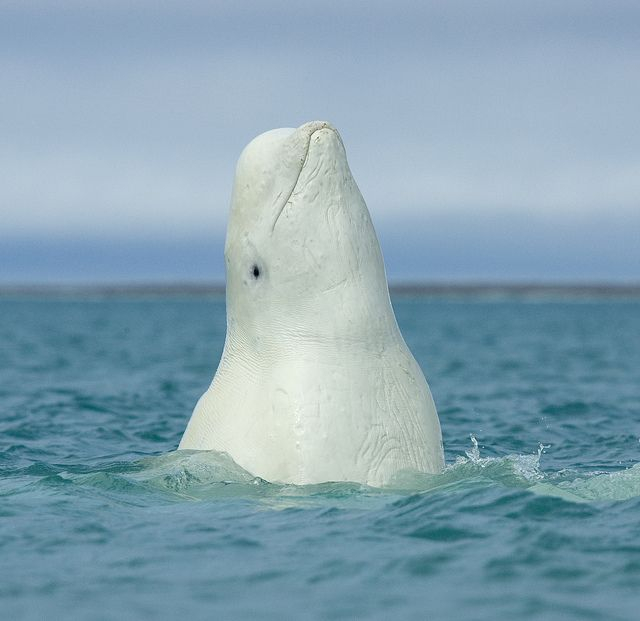
wwf.ca 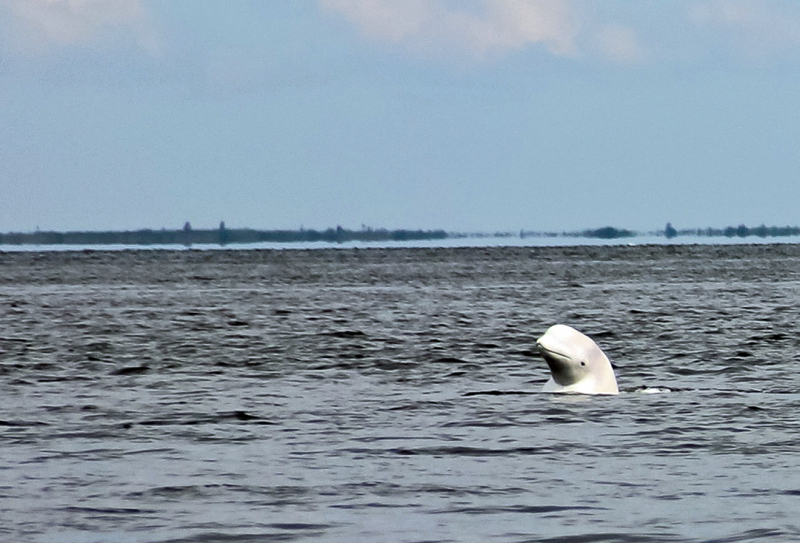
wwf.ca -
While the term "melonheads" may seem like it was coined by a middle school bully, there is some scientific justification for it. Belugas are frequently called "melonheads." All toothed whale species have a melon, which is the name given to the bulbous protrusion that fills the whale's forehead. The fatty organ may be seen morphing during whale vocalizations, which is thought to help in echolocation, a technique in which animals utilize the echoes of their sounds to locate and identify objects.
Belugas don't have vocal cords as humans do, despite being extremely noisy animals. The sound is instead focused through a lump of fatty tissue at the front of the skull known as the "melon" after being produced by the nasal air sacs and phonic lips. This organ, which is present in all toothed whales, may aid in the transmission of sound waves from the whale's head into the water.
Although these fatty melons are common in the skulls of toothed whales, a beluga's melon is much bigger, more bulbous, and more noticeable than in other species. Additionally, belugas may alter the form of their melons, which gives them more control when they target or alter their outgoing noises, in contrast to other cetaceans, which is one of the interesting facts about Beluga Wales.
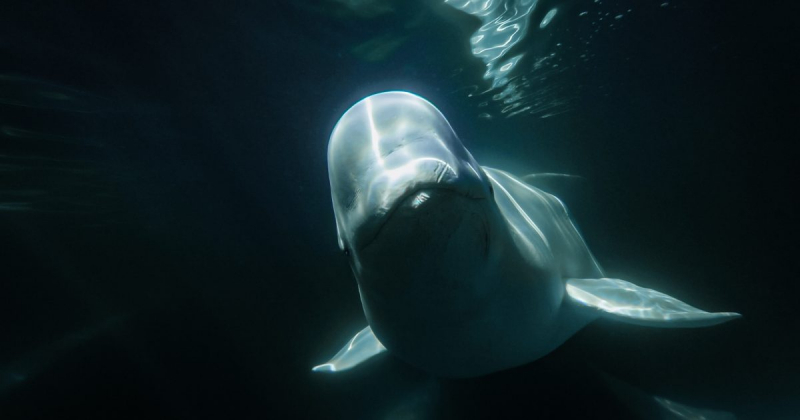
www.dailymail.co.uk 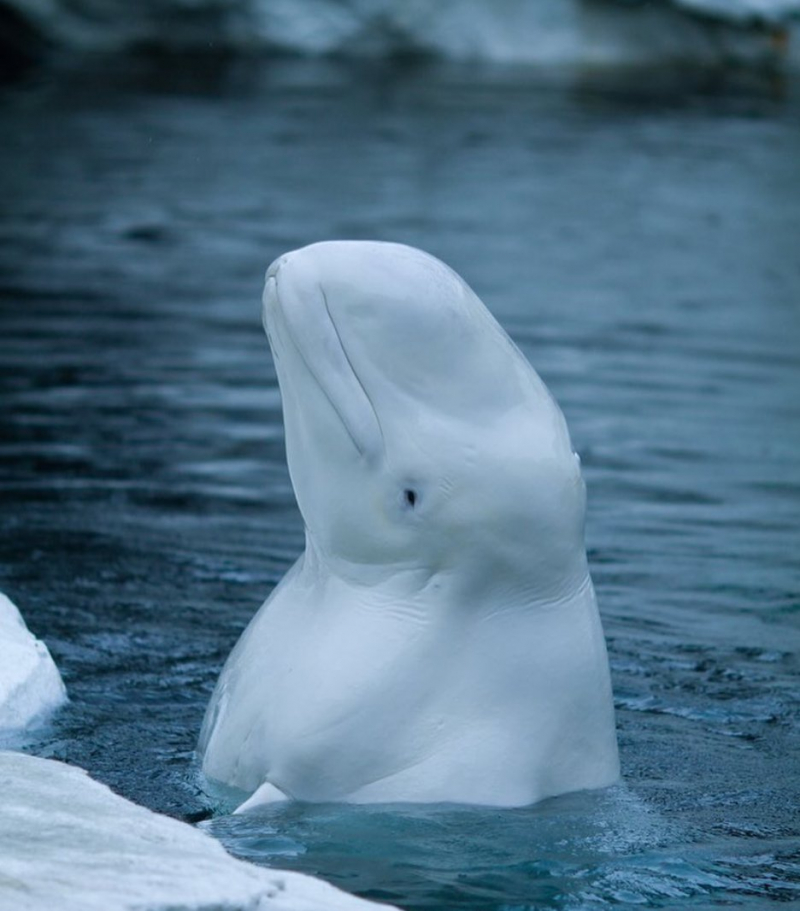
www.dailymail.co.uk -
The skin of a beluga is 100 times thicker than that of a terrestrial mammal and ten times thicker than that of a dolphin. The name "beluga" comes from the Russian word "bielo," which means "white." Undoubtedly, because it is entirely white or whitish-grey, mature belugas are rarely confused for any other species. Calves are often born grey and turn dark grey or bluish grey by the time they are a month old. To make up for the absence of fat, a calf's skin is thicker when it is born. The calf sheds its skin as it grows a thick layer of blubber. At the ages of seven years for females and nine years for males, they subsequently begin to gradually lose their pigmentation until they reach their unique white coloration.
Their coloring is supposed to function as camouflage to shield them from predators like polar bears, predators, and killer whales as they swim around sea ice in their Arctic environment which enables them to blend in with the polar ice caps. Belugas have highly developed skin sensitivity, which is crucial for their social behavior that is focused on touch. The belugas lose their skin seasonally, unlike other cetaceans. Environmental signals like temperature and salinity may cause this. The epidermis thickens and the skin might turn yellowish throughout the winter, notably on the back and fins. They lose their epidermal covering by rubbing themselves on the gravel of riverbeds as they migrate to the estuaries in the summer.
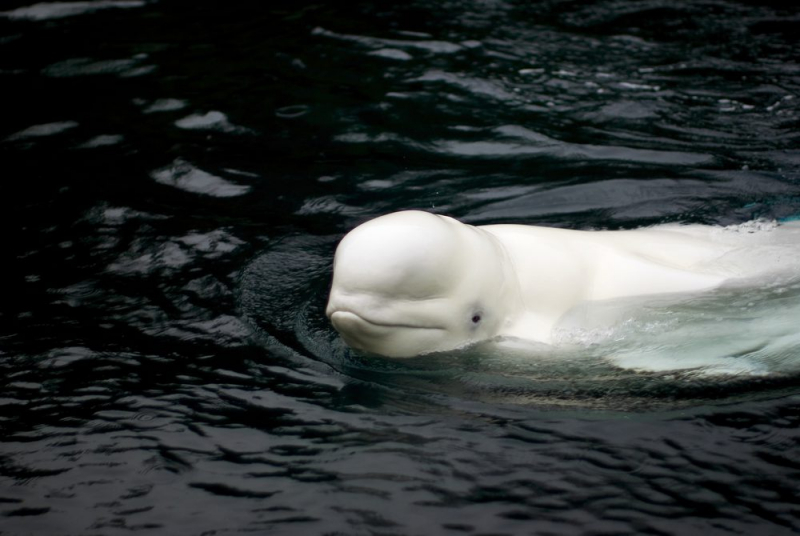
www.mentalfloss.com pacificwhitesided - youtube.com -
The hearing range of a beluga whale is far wider than that of a person. People can hear between 0.02 and 20 kHz, but belugas have a hearing range of 1.2 to 120 kHz. Imagine the variety of noises a beluga hears right now! The squeaks from our rubber Zodiac boats are one collection of noises they may be certain of hearing. These squeaks seem to attract them, along with tourists' often off-key singing, and they frequently stop over to say hello. The belugas are musical creatures and have shown a lot of interest in listening to cellist Rob Knaggs and singing tourists. They might be amused and show their adorable smiles.
Additionally, these pure white whales have superb vision both within and outside of the sea. You can bet they are gazing at you if you believe they are! Occasionally, they'll bring their young to the area and push them up to the surface so they may see a person for the first time. The eye of a beluga is very well-suited for aquatic vision. The nearsightedness that develops as a result of light rays' refraction (bending) when they travel from water to air is corrected in the air by specific characteristics of the lens and cornea.
Rod and cone cells can be seen in beluga retinas, suggesting that they may be able to perceive in both strong and low light. The absence of short wave-length sensitive visual pigments in belugas' cone cells, like in other whales, suggests that their ability to see color is less developed than that of other land animals. An oily, jelly-like mucus is secreted by glands in the inner corners of the eye sockets, lubricating the eyes and clearing away dust. This coating that resembles tears may help shield the eyes from contagious organisms.
Maui Now - youtube.com Churchill Wild - youtube.com -
The dorsal fins of certain whales and dolphins may be seen when they breach the water's surface, whereas belugas lack this characteristic, which is one of the interesting facts about Beluga Whales. In addition to making it simpler for them to glide straight beneath sheets of ice, the decreased surface area helps limit heat loss in the chilly Arctic Ocean. Besides, they do have a strong dorsal ridge along the length of their backs, which aids in breaking through ice layers.
A dorsal fin aids swimming stability and turning; it is so beneficial that it has repeatedly developed through convergent evolution (such as in fish and cetaceans). Nevertheless, a dorsal fin might have negative effects in the Arctic despite its putative advantages. A dorsal fin may also make it more difficult for belugas to move and navigate since it adds to heat loss, which is important in such a cold environment.
One way belugas have adapted to living on the sea ice is by developing blubber. Belugas must survive extremely cold water since they swim amid ice floes in and around the Arctic Circle. The U.S. National Oceanic and Atmospheric Administration (NOAA) report that despite seasonal excursions into warmer estuaries and river deltas, they still need to spend extended periods in the water as cold as 32 degrees Fahrenheit (0 Celsius). That necessitates an abundance of blubber, the thick coating of body fat that protects marine creatures from cold climates. According to NOAA, fat in belugas may make up as much as 40% of their whole body weight.
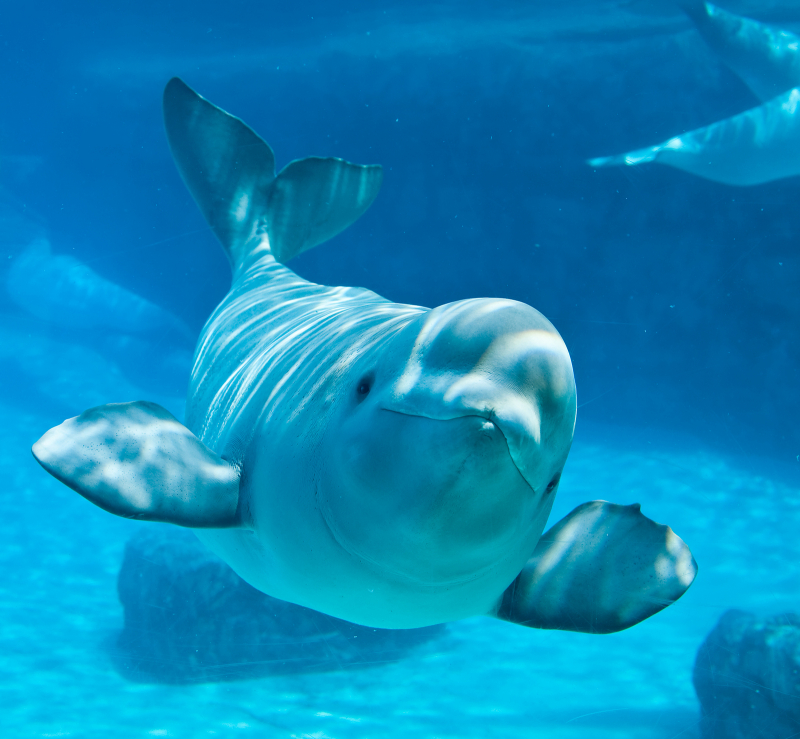
seaworld.org 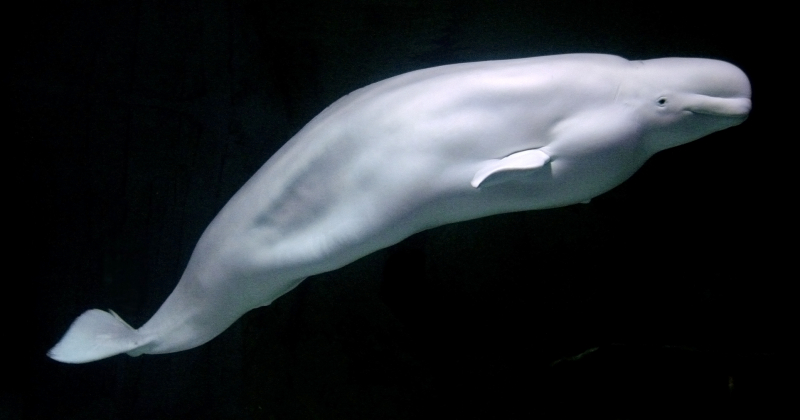
seaworld.org -
In addition to being skilled singers, belugas are also masters at blowing bubbles. A study of 44 beluga whales kept in captivity revealed that this behavior is more than simply something they find amusing. Other bubble forms are seen to have more practical uses than rings and slow-releasing bubbles, which are thought to be signs of playfulness. While whales are supposed to blow matching bubble rings as a kind of social connection, sudden bubble bursts may be a sign of a protective reaction.
Two bubble forms that have been identified as being largely fun are blowhole drips and mouth rings. These two varieties of the bubble are created more frequently by female Belugas than by male Belugas, according to the study, "which shows that female Belugas are more playful in nature than their male counterparts". A Beluga's startle reaction manifests as blowhole blasts. Adult females are more likely than adult males to form this sort of bubble, which "suggests that adult females are more reactive by nature than adult males." However, the study also discovered that juvenile males emit blowhole bursts more frequently than juvenile females, which is "reflects a rowdier intensity of play bouts in younger males than females." Although humpback whale blowhole streams are thought to be an aggressive behavior, the Canisius study found that this is not true with beluga whales. The study did discover that male Belugas (including adults and juveniles) generated blowhole streams more frequently, which may be an indication of anger.aquas shimane aquarium - youtube.com Meg Frost - youtube.com -
The International Union for Conservation of Nature (IUCN), which designated the species as Vulnerable in 1996, claims that belugas have long been susceptible to overexploitation by humans since they return to the same estuaries every summer. Legal protection has aided in the recovery of certain populations in recent decades, prompting the IUCN to downgrade belugas from Near Threatened to Least Concern in 2017.
According to the IUCN, there are currently roughly 200,000 belugas living in 21 subpopulations throughout their habitat, but there are still much fewer belugas than there were just 100 years ago, and there is still worry for their future. The species itself confronts the difficult issue of adjusting to high-speed climate change, including the reduction of Arctic sea ice, and certain subpopulations are tiny and vulnerable. Less sea ice exposes belugas to external risks such as ship noise and accidents, oil and gas sector pollution, and even competition for food from other whales. For example, belugas depend on sea ice to help them catch fish and avoid orcas.
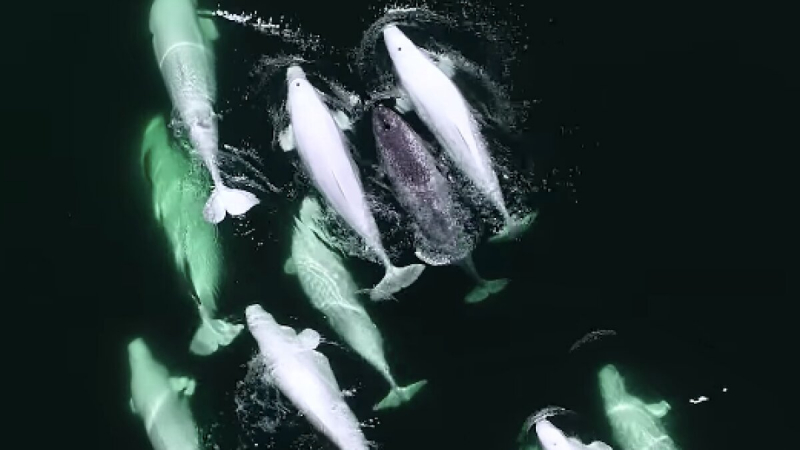
www.independent.co.uk 
www.independent.co.uk













